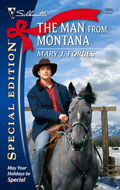|
Cindy: I've heard of "flying into the mist" and "writing by the seat of your pants"—I consider myself a pantser—however, in 2005 you wrote a website article about fogwalking in reference to your writing process. Can you explain the term, and how did you come up with it?
Mary: Well, LOL, I've never quite understood what "by the seat of your pants" meant, so maybe that's why I devised my own term. The word "fogwalking" came to me while I was on an early morning walk. But first, let me explain my writing process. In some ways it's the same today as it was back when I wrote that article. I still struggle painfully to write the synopses editors and agents require. But to quote my article: "...I don't have dozens of sticky notes, index cards...time-lines, character charts or plot grids." Rather, I get an idea. That idea bounces around in my head and, over time, begins to collect all sorts of tidbits. These tidbits eventually take shape and click into a small order. At that point, I write the first three chapters. I still can't say what's going to happen 2-3 scenes down the road, or even at the end. I just sense the story is there somewhere in the realm of my mind. Often, I'll take morning walks to mull over these story bits and get a clearer picture of the characters or scenes.
One morning, a heavy fog lay on the streets, trees and houses, obscuring my route. But as I walked, familiar landmarks came into view and I got a sense of direction. At the same time, my mind was struggling to "see" my story. I hadn't been able to grasp where it wanted to go. That was when I thought, My story is like this fog I'm walking through. The notion had me panicking a little. Story-wise, I needed to find direction and a path. I needed to find some familiar landmarks so I could walk out of the story's fog. Eventually, I found a way through the fog—literally and figuratively—and I finished that story. And the next. And the next. But I've never forgotten that morning when familiar landmarks were shrouded and unclear until I walked past them, just as elements of my scene were unclear—until they rose out of the fog in my mind.
Cindy: What an excellent and useful analogy. I've walked in literal fog only once, while visiting San Francisco, so until reading your article the term fogwalking wouldn't have occurred to me as a way to describe my own creative process. Another author once told me that my process sounded an awful lot like "digging a tunnel through a mountain—with a spoon," and she was right. Similar to you, I can see maybe a scene or two ahead, but that's it, although I might have vague notions of scenes I might write further on. And when I say "see a scene," I mean, "have some sense of." I'm not one of those writers who sees "a movie in the mind" when I write. Do you see a "movie in the mind," and does it help you through the fog?
Mary: I see movie-like bits once I've reached those foggy "landmarks" so to speak. In other words, if I've zeroed in on something that makes sense or feels right for the story, I see it clearly. I don't see the whole scene play out, just a clip of the action. Example, the heroine loading her pickup with honeybee frames from her shed, or the hero driving through a snowy night with the heroine cold and shivering beside him in the vehicle. In that snippet I see what they see, hear what they hear, smell the scents carried on the air around them. Taking that action snippet, I begin to write. And write. Until the whole scene unfolds, start to finish.
However, every writer's process is unique. In other words, instead of movie-like tidbits, you might get "still-life pop-ups" such as a character's angry face or the heroine as a store clerk. And you write your scene from those "stills." Whatever the process, it's yours and it's fine. :)
Cindy: I'm so glad to hear it! Too often we writers beat ourselves up for not being able to apply another writer's process to our own work. Mary, what's the best discovery you've ever made about a story or character while fogwalking?

Mary: In THE MAN FROM MONTANA (Dec. 2006), I realized a secret about the heroine's ancestry that I didn't see coming until I was typing the words. Afterward, I sat back and stared at the computer screen for a long minute. To this day, I have no idea where the tidbit came from, but it was huge to the heroine—and ultimately to my readers. I've had a number of emails expressing wow-like surprises.
Cindy: Well, clearly the surprise worked for your readers and peers, because THE MAN FROM MONTANA won several awards. However, now you have me thinking about your February 2008 release, FIRST-TIME VALENTINE, which was part of a continuity series for Silhouette Special Edition. First, for those who don't know, please explain what a continuity series is and how the experience of working with several authors affects your creative process.
Mary: A continuity mini-series is like a mini saga that develops over several books. Editors create a brief plot with main characters, then ask authors to write the stories. Each book has its own characters and story, but there is an underlying theme or plot point that runs through each author's story. Usually it's a mystery or some family drama that moves forward with each book, and is resolved with the last book. Working with other authors was a lot of fun. We set up our own loop and discussed such things as setting, characters' homes, the design of the town and hospital, as well as events and/or places we created that others might want to implement into their stories. Creatively, I found it a little easier because of all the brainstorming. Ideas led to offshoots in an ever expanding circle.

Cindy: Does fogwalking still apply when you're working on a continuity series, or how does it change?
Mary: While continuities offer a very brief plot, the writer still makes the story her own. In FIRST-TIME VALENTINE, I was given an overall premise (a businessman comes to take over the hospital for his corporation). But his family background and internal issues came from me. The heroine's background was a little more precise (virgin, doctor, working at a family-run hospital), but her personality, internal issues and the hero's history were mine. Also the story's development between the hero and heroine was a result of hours of mulling over what I'd been given—and what I'd added.
Cindy: Do you ever plot?
Mary: No, not in the way of true plotters. I don't make copious notes or compose outlines or characters sketches. I don't design my story from start to finish in a 25+ page synopsis. But, in recent years, I have learned to jot down every thought while I'm searching for those foggy "landmarks" of my story. These help build my synopsis. The page length varies, depending on my comfort zone with the story at that point, and the needs of my editor. I've written 5-page synopses and 11-page synopses. Before I was published, I never wrote the synopsis until I'd finished the book. Today, I write the synopsis (and create collages a.k.a. storyboards) from my notes while writing proposals or the first three chapters.
Cindy: Can you explain the storyboarding or collaging process and how it helps you develop your stories?
Mary: I'd never attempted collaging/storyboarding until I took a workshop by Jennifer Crusie and one by Susan Wiggs. These ladies are masters at the craft of collaging. From them, I learned to collect magazines and look for pictures that match my hero/heroine and bits and pieces of my story. I learned to cut out pictures and words and paste them on a blank sheet of paper (you can use any size). I learned that collaging is similar to fogwalking. You might see pictures, words, sentences in a magazine, and recognize them instinctively, although they're not yet part of your story. So you cut/paste them on the storyboard anyway and one day while you're writing a scene, that picture-word-sentence springs to life. I love collaging and always set the "board" near my computer where I can glance at my little work of art often to keep the muse on track.
Cindy: That sounds fascinating—and a lot more organized than shoving pictures and floor plans willy-nilly into a file folder, as I usually do (and then waste my time wondering and searching for which folder they're in). I'll have to try collaging sometime. However, back to that dastardly plotting (or, as I like to call it, "plodding"). Like you say, bit by bit, even a fogwalker can build some semblance of a synopsis. However, when you're a fogwalker writing your first couple of books, the synopsis is extremely difficult to craft and the inclination is not to write it until you've finished the story. Do you have any synopsis writing tips that might help aspiring writers who are fogwalkers?
Mary: Your mind is never at rest, even in sleep. So jot down whatever comes to your mind as you write, shop, cook dinner, run the kids to soccer, etc. Keep a pen/paper on your nightstand, in your purse, in the bathroom, in your favorite part of the house. Jot down those thoughts! Even if it's a word. You never know what could develop into a scene, a character or a plot point. Also, talk over tangled story parts with a writer friend. Sometimes it just takes a fresh brain to untangle the knot in your story. Once you've gleaned all the bits and pieces—or as much as you can sort through—begin putting them together into a mini synopsis. It might be only a page or two at first, but it'll help you write those first three chapters.
Cindy: Good advice. Now, I know you published your first book in 2004. Everyone loves first sale stories. Can you share yours?
Mary: I'm one of those people who got lucky at pitching at a conference. After many rejections—and conference attendances—I went to RWA National, pitched to an editor. She asked for the book—and seven weeks later bought it. Shocked me silly, LOL!
Cindy: I love that story. So many times we hear that sales almost never result from pitching at conferences. Yet, every once in a while, that's exactly how they come about. And in seven weeks? That's very inspiring.
Mary, aside from the wonderful fogwalking and synopsis-writing tips you've already shared, what's your favorite advice to give to aspiring authors?
Mary:
- Don't treat writing as a hobby. Treat it as your second job—and one day it may become your first job.
- Limit your Internet & email time! They are the worst scavengers of valuable writing time.
- Write a book you can believe in. Don't chase trends. Their bandwagons will be over the hill before you get there.
Cindy: Hmm, I don't know about that limit email time one! For some of us, it's a lifeline, LOL. Okay, to wrap up, let's talk about your current and future releases. Your May 2008 Silhouette Special Edition, THEIR SECRET CHILD, is the first of a trilogy. Can you share a little about each story with us?
 Mary: The "Home To Firewood Island" trilogy is about three half-sisters—Addie, Lee & Kat—who grew up on an island in the Puget Sound. In each book, one sister overcomes a difficult past event before she discovers her niche of happiness and love. Mary: The "Home To Firewood Island" trilogy is about three half-sisters—Addie, Lee & Kat—who grew up on an island in the Puget Sound. In each book, one sister overcomes a difficult past event before she discovers her niche of happiness and love.
THEIR SECRET CHILD begins my "Home To Firewood Island" mini-series. In this story, Addie and her high school sweetheart reunite thirteen years after they gave their baby up for adoption. Both parents forged separate lives, but suddenly the hero returns to the island...with Addie's daughter.
Book Two, AND BABY MAKES FOUR (November 2008), is about Lee, a seaplane pilot, who must resolve a tragic past issue that secretly connects her to the man she comes to love.
Book Three will be released in 2009. I don't have a title yet, but it's Kat's story. As a single mother, she operates a Bed & Breakfast on the island. One day a reclusive guest arrives and Kat's strict, regulated life is forever changed....
Cindy: They sound fantastic. I can't wait to read them. Best of luck with the trilogy and all your future stories!
An avid walker/jogger, Mary J. Forbes makes her home in the Pacific Northwest with her family. You can contact her at: www.MaryJForbes.com.
© May 2008, Cindy Procter-King
|












